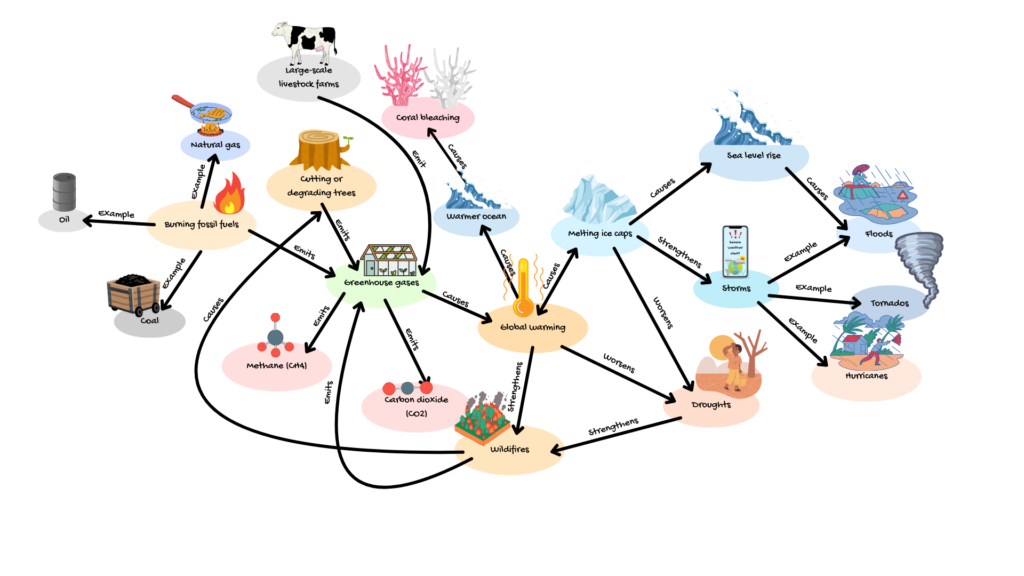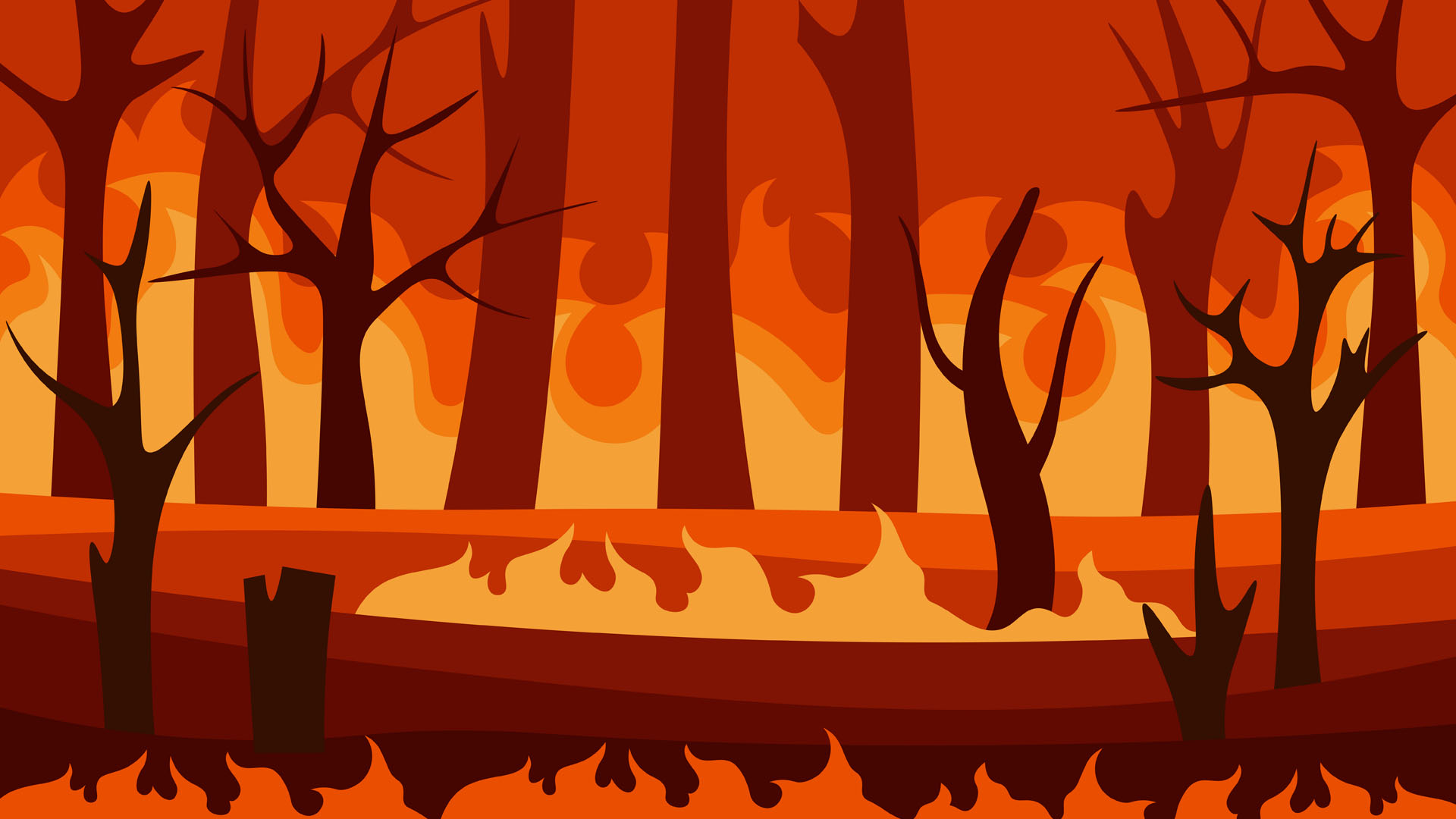
What climate change is, how it happens, its effects, and what you can do to help.
When the sun’s rays reach the surface of our planet, some of the rays are absorbed by the ground, water, and the earth’s atmosphere. A lot of them are reflected into the space, where gasses like carbon dioxide (CO₂), methane (CH₄), nitrous oxide, and others absorb and redirect this heat. Like glass in a greenhouse, these gasses trap heat, which is why they are called “greenhouse gasses,” and this process is called the “greenhouse effect.” Usually, the greenhouse effect keeps the planet at the correct temperature, and changes of a few degrees in the average temperature take thousands of years. This is slow enough that species can adapt.

But recently, because of human activities, there have been more greenhouse gasses in the atmosphere. Burning fossil fuels (oil, coal, natural gas) for energy releases a lot of carbon dioxide. Food production also causes climate change. Cows’ digestion releases methane, which traps 20 times more heat than carbon dioxide. Cutting down trees not only stops them from taking in carbon dioxide, it also makes them release their stored carbon dioxide. This causes the average temperature to rise, which is called global warming, or climate change. Additionally, human-made climate change is going too fast for species to adapt.
But this rise in average temperatures doesn’t mean that there will be no cold days, snowstorms, or colder summers. This is because there is a difference between weather and climate. Weather is how it is outside at a specific time, while climate is the weather over many years. If you look at an average temperature graph, the yearly average is very unpredictable, but the entire trend is going up. Scientists prefer the term “climate change,” or “global climate change,” because it includes all the other effects of the rise in temperatures, not just the warming.

There are many of these effects. For example, the ocean absorbs much of this warmth. When corals are stressed, which can be caused by changes in ocean temperatures, pollution, being exposed to air at low tides, etc., algae called zooxanthellae (pronounced zo · a · zan · theh · lie) leaves the corals, bleaching them. The corals can only recover if the stress is gone quickly enough and the algae comes back, otherwise they will die. The warmth also causes the ice caps to melt, causing sea levels to rise, among other effects. Warmer air has more energy, causing more and stronger storms, including stronger tornadoes and hurricanes. Warmer temperatures also cause droughts, and both of these cause more and stronger wildfires. Climate change also causes more and stronger heat waves.

This is why it is so important to do our part to reduce climate change. To help, we can reduce our carbon footprint by using less electricity and water, reducing waste, and cutting back on car usage and using it more efficiently (doing maintenance, using eco settings, etc.). Switching to clean, renewable energy and using electric cars also reduces our carbon footprint. Another way to help is to spread awareness. It also helps to buy more environmentally friendly products.

Look for seals like ‘EWG Verified’ for cleaning and skin care products; ‘FSC Certified,’ and ‘recycled’ for wood products; ‘USDA organic’ for food and some other products; ‘MSC Certified’ or ‘Friends of the Sea Certified’ for seafood; and ‘Rainforest Alliance Certified’ for anything that comes from the rainforest. We can create websites or blogs like this one, tell others, write to government officials, and sign or make petitions. We can also support or volunteer for organizations that help reduce climate change. But the most important thing is for us to significantly reduce fossil fuel usage and switch to clean, renewable energy.
Bibliography
- “Climate Change.” BrainPOP. Accessed March 19, 2024. https://www.brainpop.com/science/earthsystem/climatechange/movie/.
- Harris, Research Manager, Global Forest Watch, World Resources Institute Nancy, GIS Research Associate Gibbs World Resources Institute David, and World Resources Institute. “Climate Change: Are Forests Carbon Sinks or Carbon Sources?” World Economic Forum, February 12, 2021. https://www.weforum.org/agenda/2021/02/forests-climate-change-carbon-absorb-environment-earth-trees/.
- NOAA’s National Ocean Service. “What Is Coral Bleaching?” Accessed March 19, 2024. https://oceanservice.noaa.gov/facts/coral_bleach.html.
Images
- Greenhouse-Effect.Png. December 2017. Amazon AWS. https://s3-ap-southeast-1.amazonaws.com/subscriber.images/biology/2017/12/04052838/Greenhouse-Effect.png.
- Fossil-Fuel-Stock-Photo-Ss-Img.Jpg. December 2020. The Nation. https://www.thenation.com/cdn-cgi/image/width=896,quality=80,format=auto/wp-content/uploads/2020/12/fossil-fuel-stock-photo-ss-img.jpg.
- Global_warming_2022.Jpeg. 2022. NASA. https://climate.nasa.gov/internal_resources/2639/global_warming_2022.jpeg.
- Shutterstock-585540035.Jpg. n.d. World Atlas. https://www.worldatlas.com/r/w1200/upload/09/ed/38/shutterstock-585540035.jpg.
- Nasasfleetof.Jpg. 2017. Scx2.b-Cdn.Net. https://scx2.b-cdn.net/gfx/news/hires/2017/nasasfleetof.jpg.
- AdobeStock_198469856.Jpeg. July 2019. Trusted Heating & Air Conditioning. https://www.globalheatingairconditioning.com/wp-content/uploads/2019/07/AdobeStock_198469856.jpeg.
Other
- Graphics from and map made using Canva at https://www.canva.com.
- QuillBot at https://quillbot.com/ for grammar checker and citation generator.


